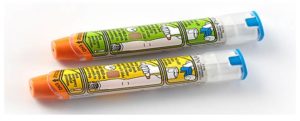Anaphylaxis in Schools – Advice From Acorn Health and Safety
From 1st October 2017, the Human Medicines (Amendment) Regulations 2017 will now allow schools in the UK to keep spare adrenaline auto injectors (AAI’s) for emergency use.
So What Does This Mean for Schools?
This recent change in legislation follows a similar change in October 2014 regarding Asthma and Inhalers, and subsequent guidance from the Department of Health allowing the discretionary power to hold an adrenaline auto injector (AAI) to be used for children who are at risk of anaphylaxis. It applies to all schools, both Primary and Secondary.
This new legislation is likely to increase awareness and knowledge, helping staff to recognise and treat anaphylaxis in schools.
For a parent of a child at risk from anaphylaxis, this represents an important reassurance that their child will have emergency treatment available on the school premises.
Our Advice
Whilst we are currently awaiting the publication of guidance from the Department of Health, Sarah Street Director of Acorn, Registered Nurse and Medicines Lead has the following advice:
“As incidences of Anaphylaxis increase, this positive change in legislation will allow those schools requiring it to obtain an adrenaline auto injector for emergency use. In many cases schools already have excellent medication practices in place, however, on occasions, the immediate availability of an adrenaline auto injector could save a child’s life…”
What Should Schools Do?
Should a school wish to implement the use of an AAI, in most cases, it’s likely that the local medication policy will require updating to ensure it clearly sets out how a child will receive the right medication, at the right time, administered in the right way.
This should include:
- How and when the AAI should be used
- How the AAI will be stored and disposed of after use
- Details of the training and support that will be provided for staff
- The process by which written parental consent is obtained and recorded in individual health care plans
- How details of children with allergies are kept and communicated amongst those requiring them
In many cases, this will require only minor changes, however, if in any doubt schools must contact those responsible for the development, review and updating of medication policies.
Schools may also wish to discuss with their community pharmacist the different AAI’s available (pictured above) and what is most appropriate for the age-group and needs of the school.
More about Anaphylaxis
In recent years’ the number of children attending education settings with a variety of medication needs has increased.
Allergy is the most common chronic disease in Europe. Up to 20% of patients with allergies struggle daily with the fear of a possible asthma attack, anaphylactic shock, or even death from an allergic reaction.
The common causes of anaphylaxis include foods such as peanuts, tree nuts, milk, eggs, shellfish, fish, sesame seeds and kiwi fruit, although many other foods have been known to trigger anaphylaxis. Non-food causes include wasp or bee stings, natural latex (rubber), and certain drugs such as penicillin. In some people exercise can trigger a severe reaction – either on its own or in combination with other factors such as food or drugs (e.g. aspirin).
The UK has some of the highest prevalence rates of allergic conditions in the world, with over 20% of the population affected by one or more allergic disorder. In the 20 years to 2012, there was a 615% increase in the rate of hospital admissions for anaphylaxis in the UK. The percentage of children diagnosed with allergic rhinitis and eczema have both trebled over the last 30 years. In the UK, allergic diseases across all ages cost the NHS an estimated £900 million a year, mostly through prescribed treatments in primary care, representing 10% of the GP prescribing budget.
The World Allergy Organisation (WAO) estimate of allergy prevalence of the whole population by country ranges between 10 – 40%. Anaphylaxis-type reactions occur in approximately 1 in 1000 of the general population.
(Statistics provided by Allergyuk.org and further references provided by The Human Medicines (Amendment) Regulations 2017 and Anaphylaxis Campaign website)
Can We Help?
Acorn understands that medication training needs to take into consideration not only the needs of the child but also those of the staff team and others such as the LEA, OFSTED and Healthcare Professionals.
If you would like any advice on how to implement these changes, or if you would like to discuss the feasibility of these changes for your school then please get in touch with us on 0117 958 2070.
You can also email Sarah on sarah@acornsafety.co.uk . Sarah regularly advises schools on medication policy, provides medication training and has the first-hand experience of supporting patients with anaphylaxis within a critical care environment.

